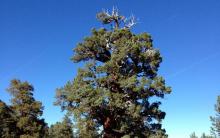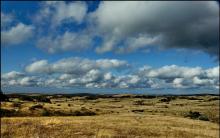Over the billions of years of our planet’s existence, certain mechanisms by which nature works have formed. Many of these mechanisms are subtle and harmless, while others are large-scale and cause enormous destruction. In this rating, we will talk about the 11 most destructive natural disasters on our planet, some of which can destroy thousands of people and an entire city in a few minutes.
11
A mudflow is a mud or mud-stone flow that suddenly forms in the beds of mountain rivers as a result of rainfall, rapid melting of glaciers or seasonal snow cover. The decisive factor in the occurrence may be deforestation in mountainous areas - tree roots hold the top of the soil, which prevents the occurrence of a mudflow. This phenomenon is short-term and usually lasts from 1 to 3 hours, typical for small watercourses up to 25-30 kilometers long. Along their path, streams carve deep channels that are usually dry or contain small streams. The consequences of mudflows can be catastrophic.
Imagine that a mass of earth, silt, stones, snow, sand, driven by a strong flow of water, fell on the city from the mountains. This stream will demolish the dacha buildings located at the foot of the city along with people and orchards. This entire stream will rush into the city, turning its streets into raging rivers with steep banks of destroyed houses. Houses will be torn off their foundations and, together with their people, will be carried away by a stormy stream.
10

Landslide is the sliding of masses of rocks down a slope under the influence of gravity, often while maintaining their coherence and solidity. Landslides occur on the slopes of valleys or river banks, in the mountains, on the shores of the seas, and the largest ones occur at the bottom of the seas. The displacement of large masses of earth or rock along a slope is caused in most cases by wetting the soil with rainwater so that the soil mass becomes heavier and more mobile. Such large landslides damage agricultural lands, enterprises, and populated areas. To combat landslides, bank protection structures and planting of vegetation are used.
Only rapid landslides, the speed of which is several tens of kilometers, can cause real natural disasters with hundreds of casualties when there is no time for evacuation. Imagine that huge pieces of soil are quickly moving from a mountain directly onto a village or city, and under tons of this earth, buildings are destroyed and people who did not have time to leave the landslide site die.
9

A sandstorm is an atmospheric phenomenon in which large quantities of dust, soil particles and grains of sand are transported by the wind several meters from the ground with a noticeable deterioration in horizontal visibility. In this case, dust and sand rise into the air and at the same time dust settles over a large area. Depending on the color of the soil in a given region, distant objects take on a grayish, yellowish or reddish tint. It usually occurs when the soil surface is dry and the wind speed is 10 m/s or more.
Most often, these catastrophic phenomena occur in the desert. A sure sign that a sandstorm is starting is sudden silence. Rustles and sounds disappear with the wind. The desert literally freezes. A small cloud appears on the horizon, which quickly grows and turns into a black and purple cloud. The missing wind rises and very quickly reaches speeds of up to 150-200 km/h. A sandstorm can cover streets within a radius of several kilometers with sand and dust, but the main danger of sandstorms is the wind and poor visibility, which causes car accidents in which dozens of people are injured and some even die.
8

An avalanche is a mass of snow falling or sliding down the slopes of mountains. Snow avalanches pose a considerable danger, causing casualties among climbers, skiers and snowboarders and causing significant damage to property. Sometimes avalanches have catastrophic consequences, destroying entire villages and causing the death of dozens of people. Snow avalanches, to one degree or another, are common in all mountainous regions. In winter, they are the main natural danger of the mountains.
Tones of snow are held on top of mountains due to the force of friction. Large avalanches occur at the moment when the pressure force of the snow mass begins to exceed the force of friction. A snow avalanche is usually triggered by climatic reasons: sudden changes in weather, rain, heavy snowfalls, as well as mechanical effects on the snow mass, including the effects of rockfalls, earthquakes, etc. Sometimes an avalanche can begin due to a minor shock such as a weapon shot or pressure on the snow of a person. The volume of snow in an avalanche can reach several million cubic meters. However, even avalanches with a volume of about 5 m³ can be life-threatening.
7

A volcanic eruption is the process of a volcano throwing hot debris, ash, and magma onto the earth’s surface, which, when poured onto the surface, becomes lava. A major volcanic eruption can last from a few hours to many years. Hot clouds of ash and gases, capable of moving at speeds of hundreds of kilometers per hour and rising hundreds of meters into the air. The volcano emits gases, liquids and solids with high temperatures. This often causes the destruction of buildings and loss of life. Lava and other hot erupted substances flow down the slopes of the mountain and burn out everything they meet on their way, causing innumerable casualties and staggering material losses. The only protection against volcanoes is general evacuation, so the population must be familiar with the evacuation plan and unquestioningly obey the authorities if necessary.
It is worth noting that the danger from a volcanic eruption exists not only for the region around the mountain. Potentially, volcanoes threaten the lives of all life on Earth, so you shouldn’t be lenient towards these hot guys. Almost all manifestations of volcanic activity are dangerous. The danger of boiling lava goes without saying. But no less terrible is the ash, which penetrates literally everywhere in the form of continuous gray-black snowfall, which covers streets, ponds, and entire cities. Geophysicists say they are capable of eruptions hundreds of times more powerful than those ever observed. Major volcanic eruptions, however, have already occurred on Earth - long before the advent of civilization.
6

A tornado or tornado is an atmospheric vortex that arises in a thundercloud and spreads down, often to the very surface of the earth, in the form of a cloud arm or trunk with a diameter of tens and hundreds of meters. Typically, the diameter of a tornado funnel on land is 300-400 meters, but if a tornado occurs on the surface of water, this value can be only 20-30 meters, and when the funnel passes over land it can reach 1-3 kilometers. The largest number of tornadoes is recorded on the North American continent, especially in the central states of the United States. About a thousand tornadoes occur in the United States every year. The strongest tornadoes can last up to an hour or more. But most of them last no more than ten minutes.
On average, about 60 people die from tornadoes each year, mostly from flying or falling debris. However, it happens that huge tornadoes rush at a speed of about 100 kilometers per hour, destroying all buildings in their path. The maximum recorded wind speed in the largest tornado is about 500 kilometers per hour. During such tornadoes, the death toll can number in the hundreds and the number of injured in the thousands, not to mention the material damage. The reasons for the formation of tornadoes have not yet been fully studied.
5

A hurricane or tropical cyclone is a type of low-pressure weather system that occurs over a warm sea surface and is accompanied by severe thunderstorms, heavy rainfall and gale-force winds. The term “tropical” refers to both the geographic area and the formation of these cyclones in tropical air masses. It is generally accepted, according to the Beaufort scale, that a storm becomes a hurricane when wind speeds exceed 117 km/h. The strongest hurricanes can cause not only extreme downpours, but also large waves on the sea surface, storm surges and tornadoes. Tropical cyclones can arise and maintain their strength only over the surface of large bodies of water, while over land they quickly lose strength.
A hurricane can cause heavy rain, tornadoes, small tsunamis and floods. The direct effect of tropical cyclones on land is stormy winds that can destroy buildings, bridges and other man-made structures. The strongest sustained winds within the cyclone exceed 70 meters per second. The worst effect of tropical cyclones in terms of death toll has historically been storm surge, the rise in sea level caused by the cyclone, which on average accounts for about 90% of the casualties. Over the past two centuries, tropical cyclones have killed 1.9 million people worldwide. In addition to the direct effect on residential buildings and economic facilities, tropical cyclones destroy infrastructure, including roads, bridges, and power lines, causing enormous economic damage to the affected areas.
The most destructive and terrible hurricane in US history, Katrina, occurred at the end of August 2005. The heaviest damage was caused to New Orleans in Louisiana, where about 80% of the city's area was under water. The disaster killed 1,836 residents and caused economic losses of $125 billion.
4

Flood - flooding of an area as a result of rising water levels in rivers, lakes, seas due to rain, rapid snow melting, wind surge of water to the coast and other reasons, which damages people's health and even leads to their death, and also causes material damage . For example, in mid-January 2009, the largest flood in Brazil occurred. More than 60 cities were affected then. About 13 thousand people fled their homes, more than 800 people died. Floods and numerous landslides are caused by heavy rains.
Heavy monsoon rains have continued in Southeast Asia since mid-July 2001, causing landslides and flooding in the Mekong River region. As a result, Thailand experienced its worst floods in half a century. Streams of water flooded villages, ancient temples, farms and factories. At least 280 people died in Thailand, and another 200 in neighboring Cambodia. Some 8.2 million people in 60 of Thailand's 77 provinces have been affected by the floods, and economic losses so far are estimated to exceed $2 billion.

Drought is a long period of stable weather with high air temperatures and low precipitation, which results in a decrease in soil moisture reserves and the suppression and death of crops. The onset of severe drought is usually associated with the establishment of a sedentary high anticyclone. The abundance of solar heat and gradually decreasing air humidity create increased evaporation, and therefore the reserves of soil moisture are depleted without replenishment by rain. Gradually, as soil drought intensifies, ponds, rivers, lakes, and springs dry up—a hydrological drought begins.
For example, in Thailand, almost every year, severe floods alternate with severe droughts, when a state of emergency is declared in dozens of provinces, and several million people feel the effects of the drought in one way or another. As for the victims of this natural phenomenon, in Africa alone, from 1970 to 2010, the death toll from droughts is 1 million people.
2

Tsunamis are long waves generated by a powerful impact on the entire thickness of water in the ocean or other body of water. Most tsunamis are caused by underwater earthquakes, during which a portion of the seabed suddenly shifts. Tsunamis are formed during an earthquake of any strength, but those that arise due to strong earthquakes with a magnitude of more than 7 on the Richter scale reach great strength. As a result of an earthquake, several waves propagate. More than 80% of tsunamis occur on the periphery of the Pacific Ocean. The first scientific description of the phenomenon was given by José de Acosta in 1586 in Lima, Peru, after a powerful earthquake, then a strong tsunami 25 meters high burst onto land at a distance of 10 km.
The largest tsunamis in the world occurred in 2004 and 2011. So, on December 26, 2004 at 00:58, a powerful earthquake of magnitude 9.3 occurred - the second most powerful of all recorded, which caused the deadliest tsunami of all known. Asian countries and African Somalia were hit by the tsunami. The total number of deaths exceeded 235 thousand people. The second tsunami occurred on March 11, 2011 in Japan after a strong earthquake of magnitude 9.0 with an epicenter caused a tsunami with a wave height exceeding 40 meters. In addition, the earthquake and subsequent tsunami caused the accident at the Fukushima I nuclear power plant. As of July 2, 2011, the official death toll from the earthquake and tsunami in Japan is 15,524 people, 7,130 people are missing, 5,393 people wounded.
1

An earthquake is an underground tremors and vibrations of the Earth's surface caused by natural causes. Small tremors can also be caused by the rise of lava during volcanic eruptions. About a million earthquakes occur throughout the Earth each year, but most are so small that they go unnoticed. The strongest earthquakes, capable of causing widespread destruction, occur on the planet approximately once every two weeks. Most of them fall on the bottom of the oceans, and therefore are not accompanied by catastrophic consequences if an earthquake occurs without a tsunami.
Earthquakes are best known for the devastation they can cause. Destructions of buildings and structures are caused by soil vibrations or giant tidal waves (tsunamis) that occur during seismic displacements on the seabed. A powerful earthquake begins with the rupture and movement of rocks somewhere deep within the Earth. This location is called the earthquake focus or hypocenter. Its depth is usually no more than 100 km, but sometimes it reaches 700 km. Sometimes the source of an earthquake can be near the surface of the Earth. In such cases, if the earthquake is strong, bridges, roads, houses and other structures are torn and destroyed.
The largest natural disaster is considered to be an earthquake of magnitude 8.2 on July 28, 1976 in the Chinese city of Tangshan, Hebei Province. According to official data from the PRC authorities, the death toll was 242,419 people, however, according to some estimates, the death toll reaches 800 thousand people. At 3:42 local time the city was destroyed by a strong earthquake. There was also destruction in Tianjin and Beijing, just 140 km to the west. As a result of the earthquake, about 5.3 million houses were destroyed or damaged so much that they were uninhabitable. Several aftershocks, the strongest of which had a magnitude of 7.1, led to even greater casualties. The Tangshan earthquake is the second-largest in history after the most destructive earthquake in Shaanxi in 1556. About 830 thousand people died then.











The most beautiful motorcycles in the world
Which sea is the cleanest in the world?
Top 10 Most Expensive Furs
The largest and most luxurious casinos in the world
Knightly orders of Europe XI - XIII centuries